#ca. 800 b.c.
Text




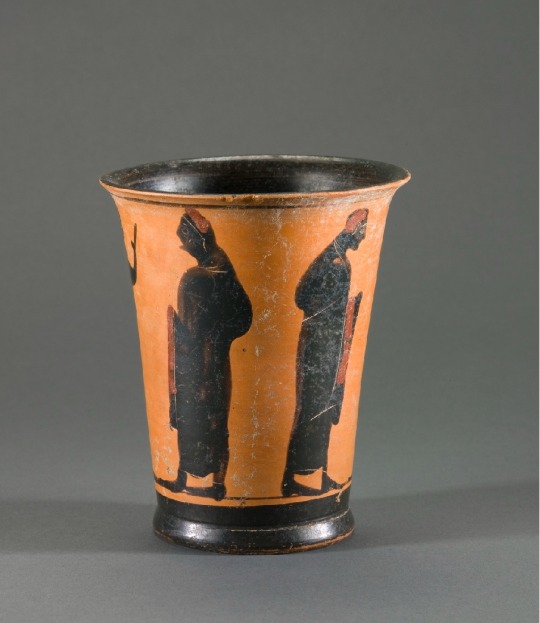

~ Beaker (kalathos) with Athletes and Trainers.
Culture: Attic, Greek
Period: Archaic period
Date: ca. 800–480 B.C.
Medium: Black-figure ceramic
#ancient#ancient art#history#museum#archeology#ancient history#archaeology#ancient pottery#archaic#attic#greece#beaker#kalathos#athletes#trainers#black-figure#ca. 800 b.c.#ca. 480 b.c.
248 notes
·
View notes
Note
Can you make a post about the evolution of Greek art from the ancient times until now in modern age?
Because we often talk about the evolution of art but unfortunately we don't appreciate after ancient times the other art movements Greece went through the centuries.
That’s true! I am sorry for taking ages to answer this but I don't know how it could take me less anyway hahaha I made this post with summaries about all artistic eras in Greek history. I have most of it under a cut because with the addition of pictures it got super long, but if you are interested in the history of art I recommend giving it a try! I took advantage of all 30 pictures that can be possibly attached in a tumblr post and I tried to cover as many eras and art styles as possible, nearly dying in the process ngl XD I dedicated a few more pictures in modern art, a) because that was the ask and b) because there is more diversity in the styles that are used and the works that are available to us in great condition in modern times.
History of Greek Art
Greek Neolithic Art (c. 7000 - 3200 BC)
Obviously, with this term we don’t mean there were people identifying as Greeks in Neolithic times, but it defines the Neolithic art corresponding to the Greek territory. Art in this era is mostly functional, there are progressively more and more defined designs on clay pots, tools and other utility items. Clay and obsidian are the most used materials.
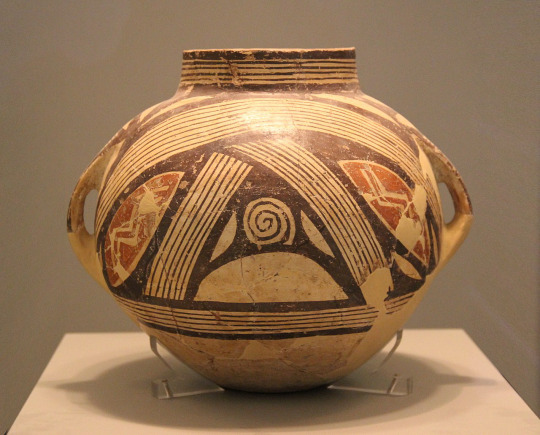
Clay vase with polychrome decoration, Dimini, Magnesia, Late or Final Neolithic (5300-3300 BC).
Cycladic Art (3300 - 1100 BC)
The art of the Cycladic civilisation of the Aegean Islands is characterized by the use of local marble for the creation of sculptures, idols and figurines which were often associated to womanhood and female deities. Cycladic art has a unique way of incidentally feeling very relevant, as it resembles modern minimalism.

Early Cycladic II (Keros-Syros culture, 2800–2300 BC)
Minoan Art (3000-1100 BC)
The advanced Minoan civilisation of Crete island was projecting its confidence and its vibrancy through its various arts. Minoan art was influenced by the earlier Egyptian and Near East cultures nearby and at its peak it overshadowed the rest of the contemporary cultures and their artistic movements in Greece. Colourful, with numerous scenes of everyday life and island life next to the sea, it was telling of the society’s prosperity.

The Bull-leaping fresco from Knossos, 1450 BC.
Mycenaean Art (c. 1750 - 1050 BC)
Mycenaean Art was very influenced by Minoan Art. Mycenaean art diverged and distinguished itself more in warcraft, metalwork, pottery and the use of gold. Even when similar, you can tell them apart from their themes, as Mycenaean art was significantly more war-centric.
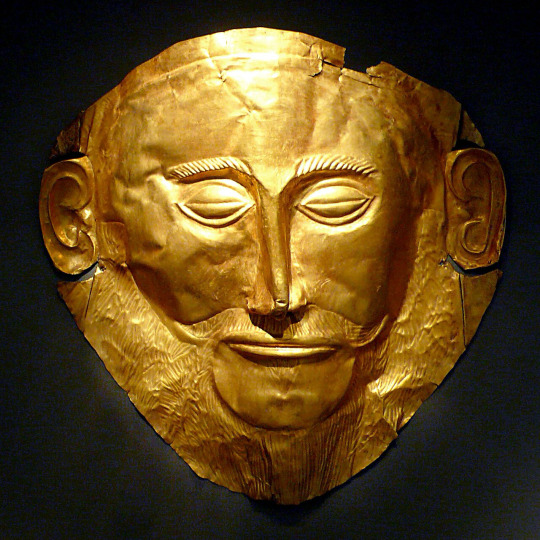
The Mask of Agamemnon in the National Archaeological Museum of Athens. The mask likely was crafted around 1550 BC so it predates the time Agamemnon perhaps lived.
Geometric Art (1100 - 700 BC)
Corresponding to a period we have comparatively too little data about, the Geometric Period or the Homeric Age or the Greek Dark Ages, geometric art was characterized by the extensive use of geometric motifs in ceramics and vessels. During the late period, the art becomes narrative and starts featuring humans, animals and scenes meant to be interpreted by the viewer.

Detail from Geometric Krater from Dipylon Cemetery, Athens c. 750 BC Height 4 feet (Metropolitan Museum, New York)
Archaic Art (c. 800 - 480 BC)
The art of the archaic period became more naturalistic and representational. With eastern influences, it diverged from the geometric patterns and started developing more the black-figure technique and later the red-figure technique. This is also the earliest era of monumental sculpture.
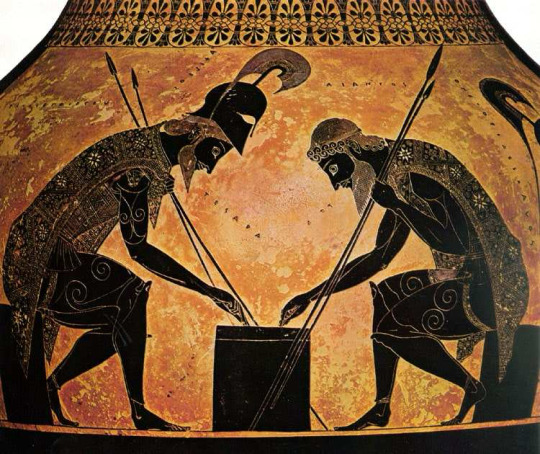
Achilles and Ajax Playing a Board Game by Exekias, black-figure, ca. 540 B.C.
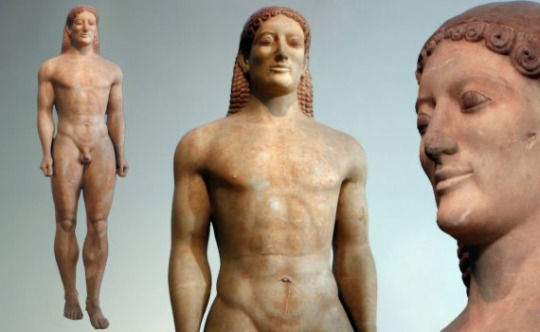
Kroisos Kouros, c. 530 B.C.
Classical Art (c. 480 - 323 BC)
Art in this era obtained a vitality and a sense of harmony. There is tremendous progress in portraying the human body. Red-figure technique definitively overshadows the use of the black-figure technique. Sculptures are notable for their naturalistic design and their grandeur.
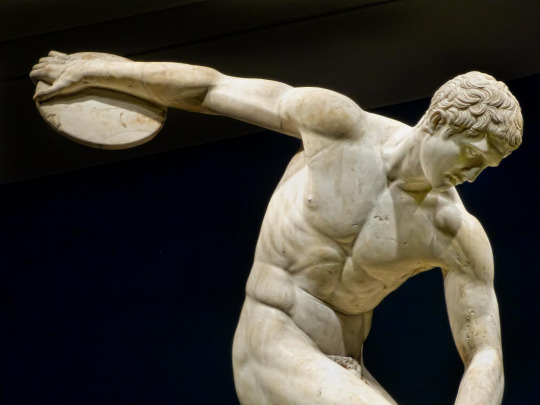
The Diskobolos or Discus Thrower, Roman copy of a 450-440 BCE Greek bronze by Myron recovered from Emperor Hadrian’s Villa in Tivoli, Italy. (British Museum, London). Photo by Mary Harrsch.

Terracotta bell-krater, Orpheus among the Thracians, ca. 440 BCE, The Metropolitan Museum of Art.
Hellenistic Art (323 - 30 BCE)
Hellenistic art perfects classical art and adds more diversity and nuance to it, something that can be explained by the rapid geographical expansion of Greek influence through Alexander’s conquests. Sculpture, painting and architecture thrived whereas there is a decrease in vase painting. The Corinthian style starts getting popular. Sculpture becomes even more naturalistic and expresses emotion, suffering, old age and various other states of the human condition. Statues become more complex and extravagant. Everyday people start getting portrayed in art and sculpture without extreme beauty standards imposed. We know there was a huge rise in wall painting, landscape art, panel painting and mosaics.

Mosaic from Thmuis, Egypt, created by the Ancient Greek artist Sophilos (signature) in about 200 BC, now in the Greco-Roman Museum in Alexandria, Egypt. The woman depicted in the mosaic is the Ptolemaic Queen Berenike II (who ruled jointly with her husband Ptolemy III) as the personification of Alexandria.

Agesander, Athenodore and Polydore: Laocoön and His Sons, 1st century BC
Greco-Roman Art (30 BC - 330 AD)
This period is characterized by the almost entire and mutually influential merging of Greek and Roman artistic expression, in light of the Roman conquest of the Hellenistic world. For this era, it is hard to find sources exclusively for Greek art, as often even art crafted by Greeks of the Roman Empire is described as Roman. In general, Greco-Roman art reinforces the new elements of Hellenistic art, however towards the end of the era, with the rise of early Christianity in the Eastern aka the Greek-influenced part of the empire, there are some gradual shifts in the art style towards modesty and spirituality that will in time lead to the Byzantine art. During this era mosaics become more loved than ever.
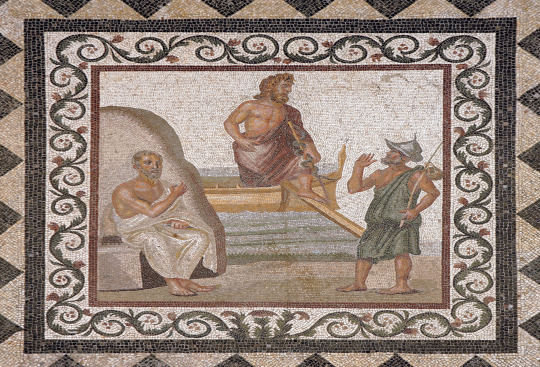
A mosaic from the island of Kos (the birthplace of Hippocrates) depicting Hippocrates (seated) and a fisherman greeting the god Asklepios (center) as he either arrives or disembarks from the island. Second or third century CE.
Introduction to Byzantine Art
Byzantine art originated and evolved from the now Christian Greek culture of the Eastern Roman Empire. Although the art produced in the Byzantine Empire was marked by periodic revivals of a classical aesthetic, it was above all marked by the development of a new aesthetic defined by its salient "abstract", or anti-naturalistic character. If classical art was marked by the attempt to create representations that mimicked reality as closely as possible, Byzantine art seems to have abandoned this attempt in favor of a more symbolic approach. The subject matter of monumental Byzantine art was primarily religious and imperial: the two themes are often combined.
Early Byzantine Art (330 - 842 AD)
The establishment of the Christian religion results in a new artistic movement, centered around the faith. However, ancient statuary remains appreciated. Most fundamental changes happen in monumental architecture, the illustration of manuscripts, ivory carving and silverwork. Exceptional mosaics become integral in artistic expression. The last 100 years of this period are defined by the Iconoclasm, which temporarily restricts entirely the previously thriving figural religious art.

Mosaics in the Rotunda of Thessaloniki, 4th - 6th century AD.
Macedonian Art & Komnenian Age (843 - 1204 AD)
These artistic periods correspond to the middle Byzantine period. After the end of the Iconoclasm, there is a revival in the arts. The art of this period is frequently called Macedonian art, because it occurred during the Macedonian imperial dynasty which generally brought a lot of prosperity in the empire. There was a revival of interest in the depiction of subjects from classical Greek mythology and in the use of Hellenistic styles to depict religious subjects. The Macedonian period also saw a revival of the late antique technique of ivory carving. The following Komnenian dynasty were great patrons of the arts, and with their support Byzantine artists continued to move in the direction of greater humanism and emotion. Ivory sculpture and other expensive mediums of art gradually gave way to frescoes and icons, which for the first time gained widespread popularity across the Empire. Apart from painted icons, there were other varieties - notably the mosaic and ceramic ones.
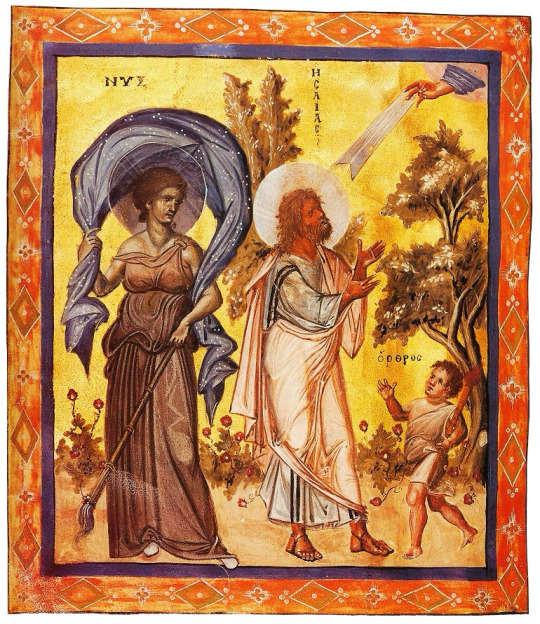
Paris Psalter, 10th century AD. Prophet Isaiah from the Old Testament in the company of the symbolisms for night (clear inspiration drawn from the ancient deity Nyx) and morning (Orthros, not to be confused with the mythological creature).
Palaeologan Renaissance (1261 - 1453)
The Palaeologan Renaissance is the final period in the development of Byzantine art. Coinciding with the reign of the Palaeologi, the last dynasty to rule the Byzantine Empire (1261–1453), it was an attempt to restore Byzantine self-confidence and cultural prestige after the empire had endured a long period of foreign occupation. The legacy of this era is observable both in Greek culture after the empire's fall and in the Italian Renaissance. Contemporary trends in church painting favored intricate narrative cycles, both in fresco and in sequences of icons. The word "icon" became increasingly associated with wooden panel painting, which became more frequent and diverse than fresco and mosaics. Small icons were also made in quantity, most often as private devotional objects.
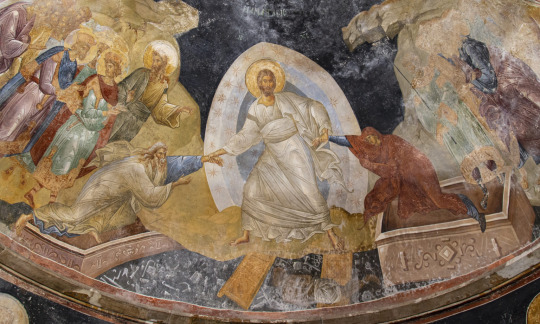
Detail of Anástasis (Resurrection) fresco, c. 1316–1321, Chora church, Constantinople (Istanbul) (photo: byzantologist).
Cretan School (15th - 17th century)
Cretan School describes an important school of icon painting, under the umbrella of post-Byzantine art, which flourished while Crete was under Venetian rule during the Late Middle Ages, reaching its climax after the Fall of Constantinople, becoming the central force in Greek painting during the 15th, 16th and 17th centuries. By the late 15th century, Cretan artists had established a distinct icon-painting style, distinguished by "the precise outlines, the modelling of the flesh with dark brown underpaint, the bright colours in the garments, the geometrical treatment of the drapery and, finally, the balanced articulation of the composition". Contemporary documents refer to two styles in painting: the maniera greca (in line with the Byzantine idiom) and the maniera latina (in accordance with Western techniques), which artists knew and utilized according to the circumstances. Sometimes both styles could be found in the same icon. The most famous product of the school was the painter Domenikos Theotokopoulos, internationally known as El Greco, whose art evolved and diverged significantly in his later years when he moved in Spain and was involved in the Spanish Renaissance, and though it often alienated his western contemporary artists, nowadays it is viewed as an incidental early birth of Impressionism in the mid of the Renaissance’s peak.

Icon by Andreas Pavias (1440-1510), Cretan School, from Candia (Venetian Kingdom of Crete). The Latin inscription suggests the icon was meant for commercial purposes in Western Europe. National Museum, Athens. (Source: https://russianicons.wordpress.com/tag/cretan-school/)

Crucifixion (detail), El Greco (Doménikos Theotokópoulos), ca. 1604 - 1614.
Heptanesian School (17th - 19th century)
The Heptanesian school succeeded the Cretan School as the leading school of Greek post-Byzantine painting after Crete fell to the Ottomans in 1669. Like the Cretan school, it combined Byzantine traditions with an increasing Western European artistic influence and also saw the first significant depiction of secular subjects. The center of Greek art migrated urgently to the Heptanese (Ionian) islands but countless Greek artists were influenced by the school including the ones living throughout the Greek communities in the Ottoman Empire and elsewhere in the world. Greek art was no longer limited to the traditional maniera greca dominant in the Cretan School. Furthermore, the Heptanesian school was the basis for the emergence of new artistic movements such as the Greek Rocco and Greek Neoclassicism. The movement featured a mixture of brilliant artists.

Archangel Michael, Panagiotis Doxaras, 18th century.
Greek Romanticism (19th century)
Modern Greek art, after the establishment of the Greek Kingdom, began to be developed around the time of Romanticism. Greek artists absorbed many elements from their European colleagues, resulting in the culmination of the distinctive style of Greek Romantic art, inspired by revolutionary ideals as well as the country's geography and history.

Vryzakis Theodoros, The Exodus from Missolonghi, 1853. National Gallery, Athens.
The Munich School (19th century Academic Realism)
After centuries of Ottoman rule, few opportunities for an education in the arts existed in the newly independent Greece, so studying abroad was imperative for artists. The most important artistic movement of Greek art in the 19th century was academic realism, often called in Greece "the Munich School" because of the strong influence from the Royal Academy of Fine Arts of Munich where many Greek artists trained. In academic realism the imperative is the ethography, the representation of urban and/or rural life with a special attention in the depiction of architectural elements, the traditional cloth and the various objects. Munich School painters were specialized on portraiture, landscape painting and still life. The Munich school is characterized by a naturalistic style and dark chiaroscuro. Meanwhile, at the time we observe the emergence of Greek neoclassicism and naturalism in sculpture.

Nikolaos Gyzis, Learning by heart, 1883.
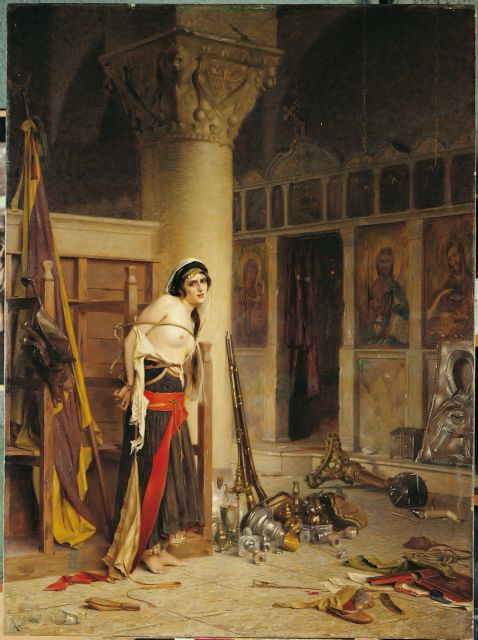
Rallis Theodoros, The Booty, before 1906.
20th Century Modern & Contemporary Greek Art
At the beginning of the 20th century the interest of painters turned toward the study of light and color. Gradually the impressionists and other modern schools increased their influence. The interest of Greek painters, artists changes from historical representations to Greek landscapes with an emphasis on light and colours so abundant in Greece. Representatives of this artistic change introduce historical, religious and mythological elements that allow the classification of Greek painting into modern art. The era of the 1930s was a landmark for the Greek painters. The second half of the 20th century has seen a range of acclaimed Greek artists too serving the movements of surrealism, metaphysical art, kinetic art, Arte Povera, abstract excessionism and kinetic sculpture.
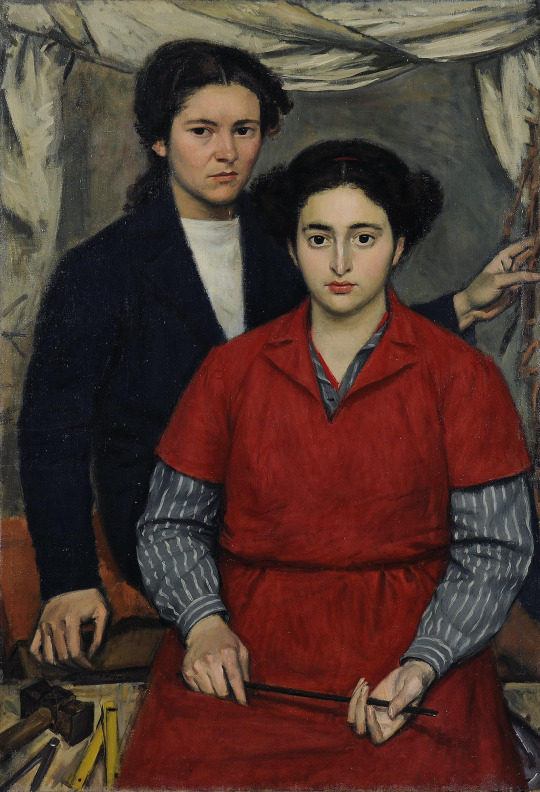
Yiannis Moralis, Two friends, 1946.
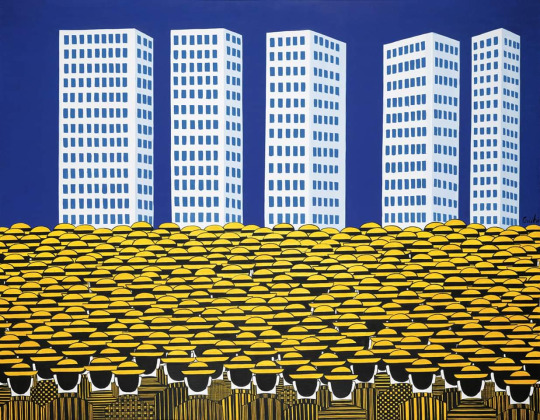
Art by Giannis Gaitis (1923-1984), famous for his uniformed little men.

By Yorghos Stathopoulos (1944 - )
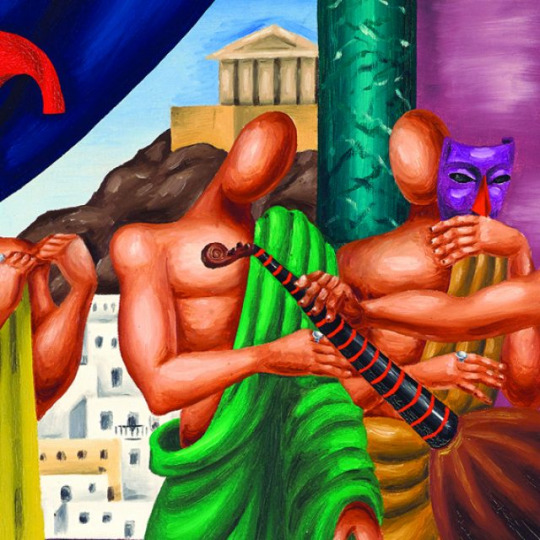
Art (detail) by Nikos Engonopoulos (1907 - 1985)
Folk, Modern Ecclesiastical and Secular Post-Byzantine Art
Ecclesiastical art, church architecture, holy painting and hymnology follow the order of Greek Byzantine tradition intact. Byzantine influence also remained pivotal in folk and secular art and it currently seems to enjoy a rise in national and international interest about it.

A modern depiction of the legendary hero Digenes Akritas depicted in the style of a Byzantine icon by Greek artist Dimitrios Skourtelis. Credit: Dimitrios Skourtelis / Reddit

Erotokritos and Aretousa by folk artist Theophilos (1870-1934)

Example of Modern Greek Orthodox murals, Church of St. Nicholas.

Ancient Greek philosophers depicted in iconographic fashion in one of Meteora’s monasteries. Each is holding a quote from his work that seems to foreshadow Christ. Shown from left to right are: Homer, Thucydides, Aristotle, Plato and Plutarch. This is not as weird as it may initially seem: it was a recurrent belief throughout the history of Christian Greek Orthodoxy that the great philosophers of the world heralded Jesus' birth in their writings - it was part of the eras of biggest reconciliation between Greek Byzantinism and Classicism.

Prophet Elijah icon with Chariot of Fire, Handmade Greek Orthodox icon, unknown iconographer. Source
If you see this, thanks very much for reading this post. Hope you enjoyed!
#greece#art#europe#history#culture#greek art#artists#greek culture#history of art#classical art#ancient greek art#byzantine greek art#christian art#orthodox art#modern art#modern greek art#anon#ask
57 notes
·
View notes
Text

CHAVÍN CULTURE, CUPISNIQUE STYLE
Stirrup-spout vessel with feline faces ca. 800-500 B.C. Burnished and stippled black ceramic; height 22.5 cm.
North coast, Chicama Valley National Museum of Anthropology and Archacology, Lima
73 notes
·
View notes
Photo
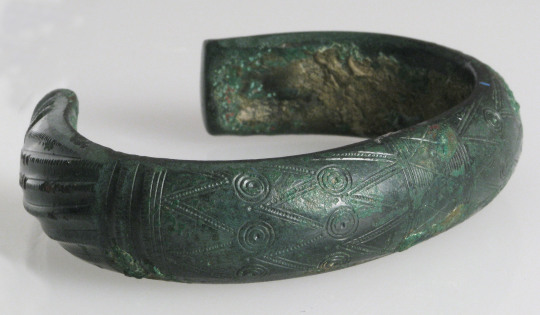
Bracelet. ca. 800 B.C.. Credit line: Gift of Alastair Bradley Martin, 1953 https://www.metmuseum.org/art/collection/search/468434
#aesthetic#art#abstract art#art museum#art history#The Metropolitan Museum of Art#museum#museum photography#museum aesthetic#dark academia
1 note
·
View note
Text
Jose Mier From Sun Valley, CA Learns About Confucius’ Family Tree
Bloodline Goes Back to 800s B.C.
Jose Mier in Sun Valley, CA searches for others with his name as a hobby but in the course of this he’s found out lots of interesting genealogy information. Case in point, Confucius’ (the Chinese philosopher) family goes back to the 800s B.C. and is in the Guinness Book of World Records.
Confucius, also known as Kong Fuzi or Kongzi, was a Chinese philosopher and…

View On WordPress
0 notes
Photo

Outer Coffin of Tabakenkhonsu 𓏏𓄿𓅡𓎡𓏏𓈖𓐍𓈖𓇓𓁐 “t3 b3k.t n ḫnsw” ‘the Servant of Khonsu’ (ca. 680–670 B.C.) | Third Intermediate Period Found 𓅟𓅓 “gmı͗” at a sealed chamber at the bottom of a small shaft sunk into the floor of the Temple 𓉞𓏏𓉐 “ḥw.t” of Hatshepsut (𓇋𓏠𓈖𓎸𓏏𓄂𓏏𓀼𓏪) “imn-ẖnmt ḥA.t-šps.wt” ‘United with Amun, Foremost of Nobel Ladies’ at Deir el-Bahri 𓉞𓉐𓁨 “ḥw.t-ḥˁḥ“ Temple of Millions of Years”, this nest of wooden 𓇋𓅓𓏲𓆭𓏫 “ı͗mw” coffins 𓏘𓂋𓋴𓊭 “qrsw contained the mummy 𓊃𓂝𓎛𓋩𓀻 “zˁḥ” of a ‘Mistress of the House’ 𓎟𓏏𓉐𓏤 “nb.t pr” named Tabakenkhonsu. This elite woman 𓊃𓏏𓁐 “s.t”, the descendent of three 𓏼 generations of Priests 𓍛𓊹 “ẖm-nṯr” of Montu 𓏠𓈖𓍿𓅱𓀭 “mnṯw” Lord of Thebes 𓎟𓌀𓏏𓈈𓊖 “w3s.t”, lived about 800 𓍩 years 𓆳𓊪𓏏𓏤𓏪 “rnpw.t” after the temple was built 𓇋𓐪𓂧𓋪𓅱𓀨 “ı͗qdw”. During this period, a number of priestly families used the temple, which still functioned as a place of worship 𓇼𓄿𓀃 “dwA”, for their tombs 𓂝𓂝𓇋𓉴 “ˁˁı͗”. The burials of Tabakenkhonsu, another Priest of Montu, Djeddjehutyiufankh, who was most likely her husband, and her probable mother-in-law, Nesmutaatneru, were found undisturbed, with dried wreaths of flowers 𓃹𓈖𓃀𓆰𓏬 “wnbw” from their funerals still adorning the coffins. 𓋹𓎬𓋹𓎬𓋹𓎬𓋹𓎬𓋹𓎬𓋹𓎬𓋹𓎬𓋹𓎬𓋹𓎬𓋹𓎬𓋹𓎬𓋹𓎬𓋹𓎬𓋹𓎬𓋹𓎬𓋹𓎬 📸 @egyptologylessons 𓋹𓊽𓋴𓆖𓎛𓇳𓎛 © (@metmuseum and description) 𓊁𓊁𓊁𓊁𓊁𓊁𓊁𓊁𓊁𓊁𓊁𓊁𓊁𓊁𓊁𓊁𓊁 #Ancientegypt #ägypten #egyptianhistory #egyptology #hieroglyphs #egypte #egitto #埃及 #مصر #egipto #이집트 #coffin #metropolitanmuseumofart #priestess https://www.instagram.com/p/Ccn5obsuEts/?igshid=NGJjMDIxMWI=
#ancientegypt#ägypten#egyptianhistory#egyptology#hieroglyphs#egypte#egitto#埃及#مصر#egipto#이집트#coffin#metropolitanmuseumofart#priestess
18 notes
·
View notes
Text

Ceramic vessel with Two Feet.
Turkey, ca. 1000-800 B.C.
17 notes
·
View notes
Text
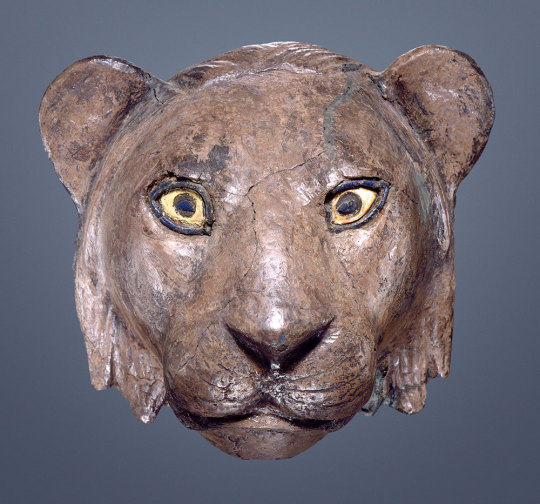
Head of a Lion, Mesopotamia, Sumerian, Ur, PG 800, Dromos of Queen Puabi’s Tomb, U.10465, Early Dynastic IIIa, ca. 2550–2400 b.c., silver, lapis lazuli, and shell, 4 3/8 × 4 3/4 in. (11.1 × 12.1 cm). University of Pennsylvania Museum of Archaeology and Anthropology, Philadelphia b17064.
75 notes
·
View notes
Text
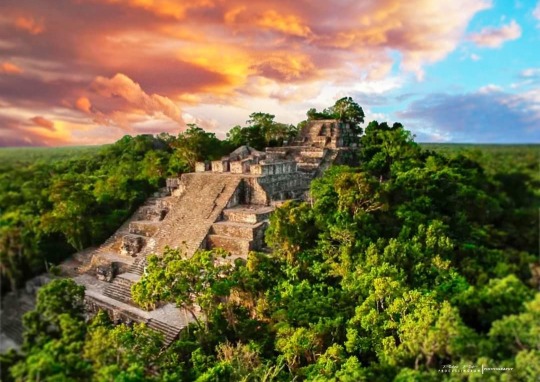
In Maya, ca means “two”, lak means “adjacent”, and mul signifies any artificial mound or pyramid, so Calakmul is the “City of the Two Adjacent Pyramids”. In ancient times, the city core was known as Ox Te’ Tuun, meaning “Three Stones”. The city existed for twelve centuries from (550 B.C. – 900 A.D.).
Calakmul’s southern location in the state of Quintana Roo places it in the center of the Peten Mayan Region. The inhabitants were influenced from both the north and south and belonged to a coalition that included the Maya settlements of El Mirador, Nakbé, and Uaxactún in the Maya lowlands. Calakmul was the largest and most powerful settlement in the coalition. This alliance was in constant conflict with its southern neighbors, especially Tikal located across the contemporary border of Guatemala.
During its heyday in the Classic Period 500 A.D. to 800 A.D., Calkmul was a powerhouse, with over 50,000 inhabitants, 6700 structures and various sacbes for commerce. The entire site is over 70 square kilometers (27 sq mi), though only a portion is open to the public. It is thought that the governing body of Calamkul had direct influence over settlements located up to 150 kms away, growing its direct impact from 50,000 inhabitants to over 200,000. If additional outer lying areas are included, Calakmul influenced over 1.5 million people. How the settlement was structured and built feels similar to Coba in the Yucatan, with a main plaza that led to various secondary urban centers. Its influence stood over 12 centuries and is thought to have more structures than any other excavated Maya settlements in the region.
2 notes
·
View notes
Photo

Costumed Figure
7th–8th century
Maya
Date: 7th–8th century
Geography: Mexico, Mesoamerica
Culture: Maya
Medium: Ceramic, pigment
Dimensions: H. 11 1/2 x W. 3 13/16 x D. 3 3/4 in. (29.3 x 9.7 x 9.5 cm)
This ceramic figurine depicts a standing male wearing a long textured bodysuit and conical headdress. His mouth is open, as if speaking, and he wears an ornament between his eyes. Incised lines on his cheeks may represent wrinkles, indicating he is a mature individual. He wears a belt and loincloth above the bodysuit, as well as a ruffled collar and large round earflares, or ornaments worn in the earlobes (see 1994.35.591a, b for an example of an earflare set, and 1979.206.1047 for individuals wearing earflare assemblages). His pectoral consists of a large round element with a zoomorphic face emerging from the top right corner. He carries a rectangular shield in his left hand; the shield is marked with patterns that probably represent feathers. The right arm of the figurine is broken at the elbow. This figurine is also a whistle; the mouthpiece of the whistle, visible from the sides and back, serves as a third support so that the figurine can stand erect.
This figurine was made from a mold, with individual characteristics added by hand. Fingerprints, remnants of hand modeling, are visible on parts of the headdress, including the right earflare and the fringes on the left side of the individual’s face. The figurine still retains large swaths of paint, indicating the entire surface would once have been brightly colored. Aside from a central vertical strip, the individual’s face is blue. The textured bodysuit is also blue. The pigment on these sections of the figurine is probably “Maya blue,” a distinctive and durable paint made by heating indigo and palygorskite, a mineral found in clay (see Crocodile Rattle, 1979.206.1143, for another example of Maya blue). The section around the individual’s shoulders is slightly faded and less textured than other parts of the figurine, indicating use wear. The individual’s loincloth and the center of his face were painted red. White paint remains on his pectoral, and on the circular elements atop his feet. The figurine is resolutely frontal: the back of the whistle lacks modeling and texture, and its smooth surface is painted red on the bottom and blue on top.
This figurine is in the Jaina style, named after a small island off the coast of Campeche, Mexico. Jaina was a Maya center occupied from the Late Preclassic period (ca. 300 B.C.–A.D. 250) to the Late Postclassic period (ca. 1200–1500), with a peak population in the Late Classic (ca. A.D. 600–800) and Terminal Classic (ca. A.D. 800–900) periods. A large number of figurines and anthropomorphic whistles similar to this one have been recovered from the island. Like this example, figurines from Jaina are mold made, with individual details added by hand. They depict a variety of subjects, from seated young women to warriors to anthropomorphic beings. While many of these artifacts lack archaeological context, excavations have recovered figurines in the burials of adults and infants. Although this style of figurine is closely associated with Jaina Island, source testing of ceramic material in other museum collections indicates that Jaina-style figurines may have been produced and traded throughout Veracruz, Tabasco, Campeche, and Chiapas, Mexico.
Jaina-style figurines seem to represent ideal “types” of people rather than individual portraits. The portliness of this figure, combined with his heavy jowls and protruding belly, suggest ties with the “Fat God,” a poorly understood character who appears throughout ancient Mesoamerican belief systems. Because his status as a deity is unclear, some scholars, such as archaeologist Christina Halperin, refer to him as the “Fat Man.” First appearing in art from the Preclassic period, the “Fat Man” is a common figurine subject, characterized by his corpulent stomach, sagging jowls, and closed, puffy eyes. The “Fat Man” is associated with humor and musical performance, and in the Classic period he may have been a ritual clown, much like the court jester in Medieval Europe. In some examples he wears a textured bodysuit, dances, and holds a fan. He also appears, as in this figurine, as a warrior with a shield. Christina Halperin (2014) suggests that depictions of the “Fat Man” as a warrior may have been ironic or humorous because they combine the accoutrements of a warrior with someone who is clearly not in fighting shape.
The many incarnations of the “Fat Man” suggest that his meaning may have varied across time and space, however, and that not all portly individuals in Maya art represent this character. Other Jaina-style figurines suggest a more generic designation as a noble or warrior. A similar work in the Cleveland Museum of Art (1963.93) wears a textured blue bodysuit and a removable helmet, and the position of his hands suggests he once carried a spear and shield. Like the Metropolitan figurine, he also has a potbelly. Another figurine in the Jaina style, photographed by Justin Kerr (K1503 in his Pre-Columbian Portfolio), carries a shield with rectangular bands of feathers almost identical to those on the shield of the Metropolitan figurine. In addition, the Metropolitan figurine may represent a local warrior “type” who appears in the art of the Northern Lowlands, especially at Oxkintok and Dscelina. At these sites in Campeche, Mexico, large relief columns depict similar rotund individuals wearing textured bodysuits and carrying shields. The bodysuit most likely represents the quilted armor worn by warriors, while the rectangular shield is carried by warriors in the Usumacinta area. Whether warrior or “Fat Man,” the rich accoutrements worn by this figure underline his noble status.
100 notes
·
View notes
Text

~ Cylinder Seal.
Date: ca. 800-400 B.C.
Place of origin: Mesopotamia
Medium: Semi-precious stone
#ancient#ancient sculpture#ancient art#ancient history#history#archeology#museum#archaeology#cylinder seal#seal#Mesopotamia#ca. 800 b.c.#ca. 400 b.c.
252 notes
·
View notes
Text
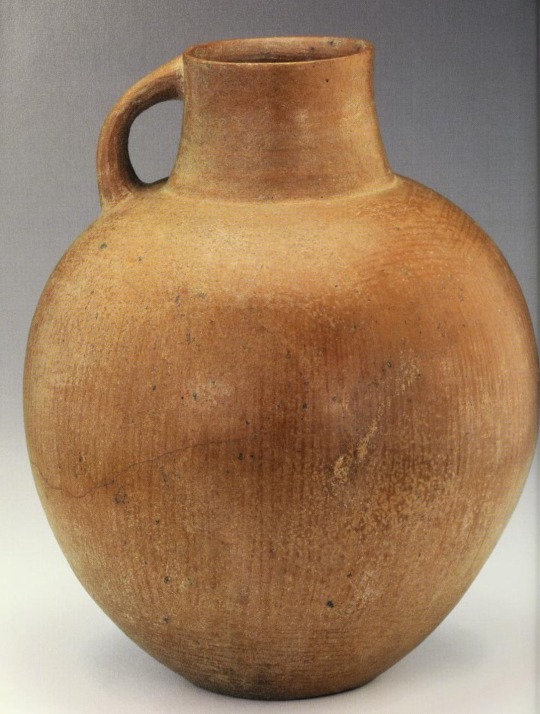
CAT. NO. 8. JUG, IRAN, IRON AGE I-II
(CA. 1400-800 B.C.), EARTHENWARE, 36.1 X
29.0. GIFT OF OSBORNE AND GRATA HAUGE.
S1998.24
13 notes
·
View notes
Text
𝙒𝙝𝙖𝙩 𝙖𝙧𝙚 𝙩𝙝𝙚 𝙗𝙚𝙨𝙩 𝙗𝙤𝙤𝙠𝙨 𝙖𝙗𝙤𝙪𝙩 𝘼𝙣𝙘𝙞𝙚𝙣𝙩 𝙂𝙧𝙚𝙚𝙘𝙚 𝙝𝙞𝙨𝙩𝙤𝙧𝙮❓

𝗚𝗘𝗡𝗘𝗥𝗔𝗟
The Oxford Classical Dictionary Simon Hornblower (first published 1949)
For more than half a century, the Oxford Classical Dictionary has been the unrivaled one-volume reference work on the Greco-Roman world. Whether one is interested in literature or art, philosophy or law, mythology or science, intimate details of daily life or broad cultural and historical trends, the OCD is the first place to turn for clear, authoritative information on all aspects of ancient culture.
Greek History: The Basics Robin Osborne (2004).
A very short, compressed primer on Greek history from the Dark Age up to the Roman conquest, written by one of the top experts.
Ancient Greece: A History in Eleven Cities Cartledge, Paul Anthony ( 2009)
Designed for a non-expert audience, but again by a top expert, this book uses a series of microhistories to tell a story of Greece’s history from the Dark Age to the Byzantine Empire.
𝗟𝗮𝘁𝗲 𝗕𝗿𝗼𝗻𝘇𝗲 𝗔𝗴𝗲 (𝗰𝗮. 𝟭𝟲𝟬𝟬 𝘁𝗼 𝟭𝟮𝟬𝟬 𝗕𝗖𝗘)
The Aegean Bronze Age Dickinson, Oliver ( 1994)
A comprehensive synthesis of a wide range of data, useful for beginners and researchers alike.
The End of the Bronze Age: Changes in Warfare and the Catastrophe Ca. 1200 B.C. — Third Edition Drews, Robert ( 1993)
This is the only halfway decent book on the Bronze Age collapse that affected Greece, Anatolia, and Syria. Drews’ rebuttal of some widely-accepted theories on the collapse is the most useful part. His own argument, that the collapse was caused by changes in military practice, is much less useful (though his theory is at least no worse than its competitors).
𝗗𝗮𝗿𝗸 𝗔𝗴𝗲 𝗮𝗻𝗱 𝗔𝗿𝗰𝗵𝗮𝗶𝗰 𝗣𝗲𝗿𝗶𝗼𝗱 (𝟭𝟮𝟬𝟬 𝘁𝗼 𝟰𝟳𝟵 𝗕𝗖𝗘)
Archaic Period (c. 800- 479 BCE), Greek Dark Ages c. 1100 — c. 800 BC
Archaic Greece: The Age of Experiment by Snodgrass, Anthony ( 1980)
A classic book: though it has been superceded in some ways, this can probably be regarded as embodying the conservative orthodoxy on the period.
The Trojans and their Neighbours Trevor Bryce (2006)
Though focused on Troy, this is currently the best book that deals with the relationship between Bronze Age Greeks and the peoples of Anatolia.
Greece in the Making 1200–479 BC Osborne, Robin ( 1996)
One of the definitive surveys of Dark Age and Archaic Greece.
A Companion to Archaic Greece Kurt Raaflaub and Hans van Wees (2009).
A thorough guide with over thirty chapters written by world experts.
(TEXTBOOK) A History of the Archaic Greek World: ca. 1200–479 BCE by Hall, Jonathan ( 2006)
Another of the definitive histories of Dark Age and Archaic Greece, by one of the greatest living historians of the period.
“Scholars as well as students of historical practice and specialists in Greek history will find this book indispensable … Highly recommended.” (Choice)
“Very attractive physical appearance … an extensive bibliography and index. Hall’s style is clear and crisp … .The book is to be recommended.” (Canadian Journal of History)
𝗖𝗟𝗔𝗦𝗦𝗜𝗖𝗔𝗟 𝗣𝗘𝗥𝗜𝗢𝗗 (𝟰𝟳𝟵 𝗧𝗢 𝟯𝟮𝟯 𝗕𝗖𝗘)
(upper-level undergraduates textbook) A History of the Classical Greek World: 478–323 BC P.J. Rhodes (2006).
Partner to Jonathan Hall’s textbook on Archaic Greece, listed above. Both provide accessible and up-to-date overviews of the period they cover.
“A leading authority on Athens, Rhodes has written a superbnarrative of Classical Greece for upper-level undergraduates:lucid, concise, and balanced. Welcome additions to the secondedition are chapters on life and culture, and brief selections fromcontemporary sources.”
(undergraduates textbook) The Greek World 479–323 BC Hornblower, Simon ( 1983)
A frequently used overview, written by a top scholar. Hornblower also pays a nice amount of attention to cities other than Athens and Sparta.
`To write a standard history which contains the essential material and yet is interesting and says things which have not been said before is one of the hardest tasks. Hornblower has performed it excellently.’ — Times Literary Supplement
`Packed with worthwhile ideas and impressive erudition. It will stimulate thought’. — David Whitehead, Classical Review
`An undergraduate text book which neither the professional ancient historian can afford to ignore nor the interested non specialist fail to read with profit and pleasure’ — History Today
𝗛𝗲𝗹𝗹𝗲𝗻𝗶𝘀𝘁𝗶𝗰 𝗣𝗲𝗿𝗶𝗼𝗱 (𝟯𝟮𝟯 𝘁𝗼 𝟯𝟭 𝗕𝗖𝗘)
(TEXTBOOK) The Greek World After Alexander 323–30 BC by Shipley, Graham ( 1999)
An introduction to the Hellenistic Period. For more in-depth detail, the researcher will still need to go to Peter Green’s enormous Alexander to Actium (1990).
“the seventh volume to appear in Routledge ‘History of the Ancient World’ series is clearly and sensibly written, has an excellent and original selection of tables, maps, diagrams, and photographs, and provides and thorough, reliable, and up-to-date introduction to key topics. — Zofia H. Archibald, University of Liverpool.”
(TEXBOOK) Thundering Zeus: The Making of Hellenistic Bactria by Holt, Frank L. ( 1999)
A good introduction to Greek culture outside of its traditional homelands, and more specifically Greek cultures of the Hellenistic era. Well researched, and highly current.
A Companion to the Hellenistic World by Erskine, Andrew ( 2003)
A thorough guide with nearly thirty chapters written by world experts.
Alexander the Great in His World by Thomas, Carol G. ( 2006)
A fairly academic but very good biography of Alexander.
“An engaging and persuasive book, which offers a newperspective … .It will maintain the interest of specialists… yet remain accessible to the general reader.”Canadian Journal of History
𝗚𝗿𝗲𝗲𝗰𝗲 𝘂𝗻𝗱𝗲𝗿 𝗥𝗼𝗺𝗲 (𝟭𝟰𝟲 𝗕𝗖𝗘 𝘁𝗼 𝟯𝟵𝟱 𝗖𝗘)
Troy Between Greece and Rome: Local Tradition and Imperial Power by Erskine, Andrew ( 2001)
In this book Andrew Erskine examines the role and meaning of Troy in the changing relationship between Greeks and Romans, as Rome is transformed from a minor Italian city into a Mediterranean superpower. The book seeks to understand the significance of Rome’s Trojan origins for the Greeks by considering the place of Troy and Trojans in Greek culture. It moves beyond the more familiar spheres of art and literature to explore the countless, overlapping, local traditions, the stories that cities told about themselves, a world often neglected by scholars.
“A detailed and spirited sifting of evidence.” — Times Higher Education Supplement
Greek Literature and the Roman Empire: The Politics of Imitation by Whitmarsh, Tim ( 2002)
Greek Literature and the Roman Empire uses up-to-date literary and cultural theory to explore the phenomenal rise of interest in literary writing in Greece under the Roman Empire. Greek identity cannot be properly understood without appreciating the brilliant sophistication of the writers of the period, whose texts must be considered in the historical and cultural context of the battles for identity that raged under the vast, multicultural Roman Empire.
“An important contribution to the study of the so-called ‘Second Sophistic’ period…. Whitmarsh offers illuminating and provocative readings of texts both familiar and less known.” — Choice
Local Knowledge and Microidentities in the Imperial Greek World by Whitmarsh, Tim ( 2010)
“The nine chapters, whose authors represent an all-star cast of thinkers about this period, are all innovative and well-written.”
Bryn Mawr Classical Review
𝘼𝙩𝙝𝙚𝙣𝙨 𝙖𝙣𝙙 𝘼𝙩𝙝𝙚𝙣𝙞𝙖𝙣 𝘿𝙚𝙢𝙤𝙘𝙧𝙖𝙘𝙮
(textbook) Mass and Elite in Democratic Athens: Rhetoric, Ideology, and the Power of the People Ober, Josiah ( 1989)
Examines the political dynamics between different classes in democratic Athens, with an emphasis on the role of persuasive speaking in the assembly and the court system.
The Athenian Democracy in the Age of Demosthenes: Structure, Principles, and Ideology by Hansen, Mogens Herman ( 1991)
A comprehensive account of the workings of Athenian democracy and of Athenian political ideology.
𝗦𝗣𝗔𝗥𝗧𝗔 𝟵𝟬𝟬𝘀–𝟭𝟵𝟮 𝗕𝗖
(textbook) Sparta and Lakonia: A Regional History 1300–362 BC by Paul Cartledge (1979).
While dated in many ways, this remains one of the pillars of scholarship on Sparta, and one of the works responsible for reviving the subject in the modern academy
(textbook) Spartans: A New History Nigel M. Kennell (2010)
An accessible new introduction to Sparta, taking into account the latest scholarship transforming our view on the subject.
Sparta by Whitby, Michael ( 2001)
An up-to-date collection of studies on aspects of Spartan history and society, most of them by the world’s top historians of Sparta.
(textbook) A Companion to Sparta Anton Powell (2017)
A collection of summaries of the very latest research on Sparta, written by the foremost scholars in the field.
𝗚𝗿𝗲𝗲𝗸 𝗪𝗮𝗿𝗳𝗮𝗿𝗲
The Ancient Greeks at War Louis Rawlings (2007
Perhaps the finest recent introduction to the topic; up-to-date and comprehensive.
“This is a fine book, which strikes a judicious balance between accessibility and scholarship, covering a much wider range of topics than most books on warfare, and offers an intelligent and original interpretation of its subject.” — Hans van Wees, University College London
Classical Greek Tactics: A Cultural History Roel Konijnendijk (2017)
A comprehensive reassessment of how and why Greeks fought pitched battles.
The Peloponnesian War by Kagan, Donald ( 2003)
Written by one of the top experts on the war, this intelligent account is a condensed version of his four-volume history first published in the 1960s.
𝗦𝗼𝗰𝗶𝗲𝘁𝘆 𝗮𝗻𝗱 𝗘𝗰𝗼𝗻𝗼𝗺𝘆 𝗼𝗳 𝗔𝗻𝗰𝗶𝗲𝗻𝘁 𝗚𝗿𝗲𝗲𝗰𝗲
The Rise and Fall of Classical Greece Josiah Ober (2015)
An attempt to explain the spectacular wealth and impressive achievements of Classical Greece through models from economic theory and game theory
The Ecology Of The Ancient Greek World by Sallares, Robert ( 1991)
A tremendously important (though not always well-written) study of the relationship between the environment, the realities of agrarian economy, and human society.
The Invention of Coinage and the Monetization of Ancient Greece by Schaps, David ( 2003)
A useful and sane study of the development of currency and its role in Greek society.
A Companion to Ancient Greek Government Hans Beck (2013)
A collection of chapters on all aspects of Ancient Greek government — its different forms, institutions, practices, and values.
Courtesans and Fishcakes: The Consuming Passions of Classical Athens James Davidson (1997)
An exploration of the theme of desire and the Greek obsession with controlling it; a survey of all the things and people the Greeks desired.
Source:
Late Bronze Age collapse — Wikipedia
Map of Archaic Ancient Greece (750–490 BC)
AskHistorians’s ‘ancient-world’ books on Goodreads (53 books)
books/europe — AskHistorians
Footnotes
[1] Archaic Greece — Wikipedia
[2] Greek Dark Ages — Wikipedia
[3] Classical Greece — Wikipedia
[4] Hellenistic period — Wikipedia
[5] Greece in the Roman era — Wikipedia
[6] Sparta — Wikipedia
[7] Ancient Greek warfare — Wikipedia
[8] Ancient Greece — Wikipedia
[9] Ancient Rome — Wikipedia
Image source: https://upload.wikimedia.org/wikipedia/commons/4/49/%22The_School_of_Athens%22_by_Raffaello_Sanzio_da_Urbino.jpg
#ancient greece#ancient greek#sparta#hellenistic period#classical period#archaic period#late bronze age#anatolia#alexander the great#troy#greek literature#athenian dem#athenian democracy#the peloponnesian war#history books#history reading
1 note
·
View note
Text
Languages that Disappeared
https://www.grunge.com/118399/ancient-languages-completely-disappeared/
Around 400 languages have gone extinct over the last century alone + estimated that half of the world's remaining languages will die out by end of this century
Norn → Vikings settled Shetland and Orkney islands of Scotland and set up camp around 800 A.D → introduced Norm (evolved from Old Norse and spoken exclusively on these island); in later middle ages Scots English took over, and last Norn speaker died ca. 1850
Etruscan → both spoken in Rome around same time; before the Romans took over in 500 B.C., the Etruscans ruled much of Italy
Etruscan language doesn't seem related to other nearby languages and almost no permanent inscriptions left; 2016 discovery of sandstone slab with 70 Etruscan letters cleared things up
Bo → one of oldest languages spoken at India’s Andaman Islands
In 2010, the last speaker of Bo died at the age of 85; member of the Great Andamanese, a tribe thought to have lived on the island for as many as 65,000 years.
British colonized the Andaman Islands in 1858 → the originally ten distinct tribes were 5,000 strong at the time but most were killed by the settlers or new diseases
Today rely on government assistance + alcohol problems are rife; only 52 people remain
Manx Gaelic → related to Irish and Scottish and traditionally spoken on the Isle of Man, Manx Gaelic started to decline dramatically in the 19th century; last native speaker died in 1964
However in 20th century revival was administered with the establishment of Bunscoill Ghaelgagh in 2001, a primary school that teaches almost entirely in Manx → reclassification
Revival with social media efforts, animation projects, learning apps, Manx music → now 1,800 people said they could use Manx Gaelic in some
Eyak → language of Alaska Natives; last fluent speaker died in 2008 after life long language preservation efforts; picked up by young Frenchman who teamed up with linguist and now works on English-to-Eyak dictionary
Ubykh → Caucasian language, two vowels, 80 consonants; lasts speaker died in 1992
Due to Russian subjugation of the Muslim population in the northern Caucasus in the 1860s, the Ubykh people were driven from the eastern shores of the Black Sea and scattered across Turkey → forced to assimilate and stopped teaching their children how to speak Ubykh in favor of more useful languages
Also: tradition for newly married couple to adopt the simpler language of the two just to make things easier
Sumerian → culture blossomed and thrived in ancient Mesopotamia around 3500 B.C; their language is the world's earliest known written language around 3.000 BC but the culture disappeared around 2000 BC (end spurred on by 200-year drought brought on by climate change)
Akkadian → empire swept across Mesopotamia around 2500 BC; language written in cuneiform script and replaced Sumerian as dominant language, before it splintered off into other dialects and disappeared by 100 A.D.
Semitic language; grammar and structure are very similar to modern Arabic and Hebrew.
Akkadian riddles were found and translated on a 3,500-year-old tablet in 2012
2011: 21 volume dictionary of Akkadian, published online after 90 years
Proto Indo European → so old that it predates writing; spoken from around 4500 to 2500 B.C
Reconstruction in 1868; fable about sheep and horses
Coptic → Egyptian language written (mostly) in the Greek alphabet; Coptic replaced at hieroglyphic writing style as Christianity spread through Egypt in the second century A.D. flourished until Arabic became the dominant language in the country in the seventh century, and Coptic eventually disappeared from everyday use.
Coptic was initially introduced as a way of easily translating holy books from Greek, but Coptic also encompassed a rich culture of art and literature outside religion
Coptic church still uses Coptic language for religious rituals today
Some places in Egypt still teach Coptic classes; either university or rural areas
1 note
·
View note
Photo

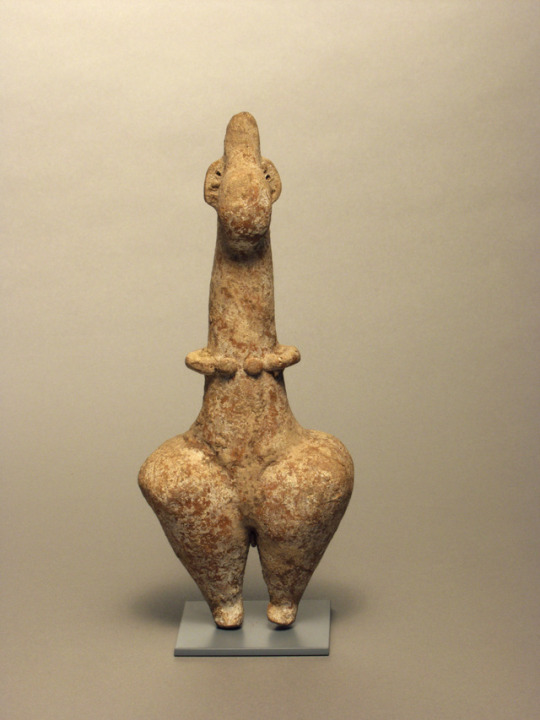
Female figurine
Northern Iran, Amlash, ca. 1000–800 B.C.
Place made: Iran
Terracotta
Princeton University Art Museum
31 notes
·
View notes
Photo

Disk from a Reel
Irish, ca. 800 B.C.
Medium: Gold
144 notes
·
View notes